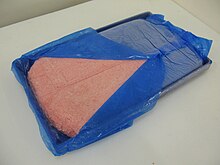Mechanically separated meat
Among MSM , and bone scrapings , one understands machine of bone dissolved meat parts, in which the structure of the muscle fibers is changed. The food law definition of muscle meat no longer applies and must be labeled accordingly in accordance with Annex VII Part B No. 18 of the European Food Information Regulation. It can be used for the production of many products and is an inexpensive alternative to processing other meats. Mechanically separated meat is pasty after production and looks similar to minced meat , but has a different composition.
Since the BSE scandal, mechanically separated meat from cattle , goats and sheep may no longer be produced or used in many European countries where other animals are required to label their products.
Manufacturing
Since the manual removal of the remaining meat is a very labor-intensive process, several machine methods are used:
- The meaty bones are roughly chopped up and then pushed through a perforated cylinder . The bone and cartilage parts remain in the cylinder while the remaining meat is collected underneath.
- Alternatively, the bones with residual meat are passed through high-pressure rollers for separation.
- In the case of less mechanized slaughter, the bones are held against the rotating brush heads made of wire or hard rubber bristles, which scrape off the meat residues.
- The meat can be separated from the bone using a high pressure water jet, as is the case with chickens for molded chicken meat in chicken nuggets .
The material to be separated must not be older than five days post mortem . The temperature of the bones must be brought to below 2 ° C after slaughter and must not exceed it until they are separated.
Mechanical pressing through a filter system squeezes some of the calcium out of the bones and thus gets into the separated meat. The maximum limit of 0.1% calcium in fresh produce applies. This value can only be determined by a laboratory. The pressing creates heat. The mechanically separated meat quickly reaches higher temperatures and has to be cooled immediately. According to Section 15 Tier-LMHV, storage is only permitted at +2 ° C or deep-frozen at −18 ° C.
The shelf life of the separated material is between three months and half a year. The best before date is based on microbiologically determined laboratory values. Usually the material is shock frozen in blocks and placed on pallets. At the end of the manufacturing process, microbiological limit values apply for the aerobic mesophilic bacterial count and E. coli , which must be checked regularly. If salmonella can be detected, it may only be processed in heat-treated meat products.
commitment
Mechanically separated meat can be used in the production of various sausage products and can also be fried, it is suitable for the production of broth or meat pastes. It can also be used as a feed additive for pet food . In Germany 70,000 tons of mechanically separated meat are processed every year.
BSE
With the first reports of the BSE disease , the production process and the use of the meat separated came under criticism. Due to the previous crushing of the bones and the high pressure with which the bone / meat mass is pressed through the cylinder, it cannot be ruled out that nerve tissue, tendons and bone remnants as well as parts of the spinal cord end up in the further processing. These residues are considered to be potential carriers of prions and thus a possible trigger of BSE disease in animals and Creutzfeldt-Jakob disease in humans.
The production and processing of cattle separator meat has therefore been prohibited since October 1, 2000; Mechanically separated meat from other animals must be labeled on their packaging.
Bad word of the year
“Mechanically separated meat” was another “bad word” when voted for the bad word of the year in 2000, alongside the “winner” National Liberated Zone . In the opinion of the jury, the term is a “serious-sounding description of slaughterhouse waste that is particularly inappropriate when BSE is suspected”.
Individual evidence
- ↑ Regulation (EC) No. 853/2004
- ↑ Patent DE102004003923B4 : Machine for removing the remaining meat from meat-bearing bones. Published on September 25, 2008 , inventors: Georg Krause, Bernd Marquardt.
- ↑ Annex IV (calcium content of mechanically separated meat) VO (EG) 2074/2005 (EG-HygieneDVO food of animal origin) (PDF)
- ↑ Regulation (EC) No. 2073/2005 of the Commission of November 15, 2005 on microbiological criteria for food (PDF)
- ↑ The Unworts from 2000 to 2009. In: unwortdesjahres.net. Technical University of Darmstadt, archived from the original on March 25, 2016 ; accessed on March 23, 2016 .

